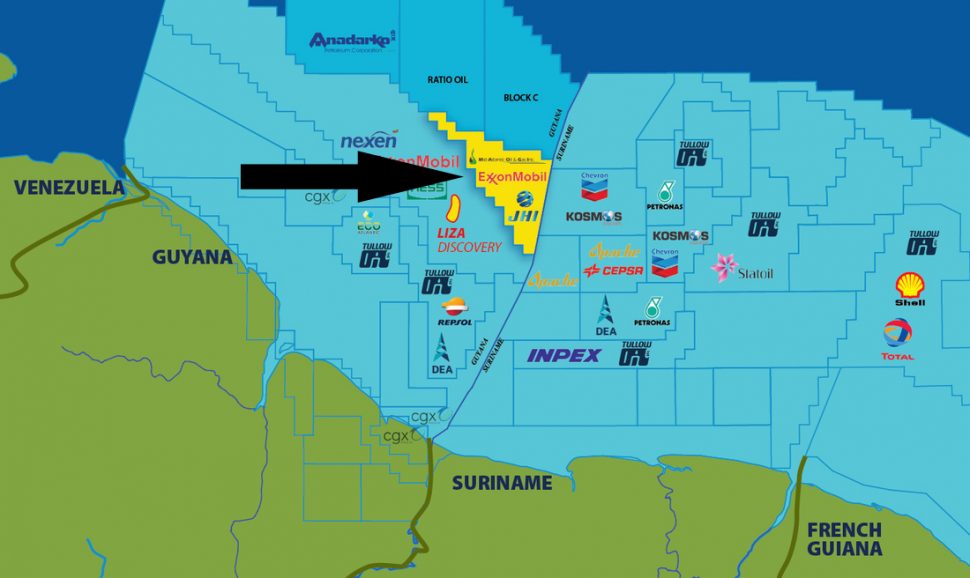With only one offshore ultra-deep oil block remaining, the PPP/C government has not yet made a decision on the mechanism for disposal of the 9000 km² area offshore, called Block C, Vice President Bharrat Jagdeo says.
Jagdeo, who holds the portfolio for oversight of the oil and gas sector, told Stabroek News that while a decision has not yet been made, when it is, competition and transparency will be the hallmarks of the process.
“We have not decided as yet or formed a decision as to the particular method for allocating new licensing,” he said.
“However, when it is done it would have to be consistent with our manifesto promise, that the process be a competitive and transparently done one,” he added
In May of this year, and during the elections impasse, the now disbanded Department of Energy (DoE) had stated that it was currently wrapping up the contract details for a seismic study that should have begun this year to gather further data to guide the bidding process for Block C, an area to the north-east of the lucrative Stabroek block.
“We are waiting on them to sign off and then we can make a formal declaration,” then Director of the DoE, Dr. Mark Bynoe had said, while explaining that procurement arrangements for the contracted company to undertake the study would have soon been completed and he would have then informed the public.
However, no follow up on the study was announced and two months after, the government changed and started execution of its own plans for the sector.
It is unclear if a company was chosen or if the survey was completed.
In July of last year, several companies placed multi-million US dollar bids to undertake the offshore study: Petroleum Geo-Services (PGS), which bid US$28.5 million; TGS Geological Company, which bid US$28.7 million; Fugro USA Marine, which bid US$10.9 million; GEREX Limited, which bid US$7.3 million; ION Geophysical Corporation, which bid US$44.8 million; and CGG Services UK Limited, which did not place a bid at the time.
PGS is a United Kingdom company that had in 2008 done a similar study for both ExxonMobil and the Government of Guyana.
It was the sale of those 2D packages that saw a renewed interest in the offshore area and US oil company Anadarko subsequently taking a stake in the offshore Roraima Block or Block A. In 2012, the company was granted an exploration licence for the block.
Bynoe had said that the study will expand on the past seismic works as it will give more detailed delineation and trapping information of the subsea surface of Block C. As a result, both the country and the data purchaser stand to gain more as they will both be in a better position to gauge the worth of the area. “In terms of going to a potential licensing round… you do not want to be buying a puss in bag,” he said.
Selling data packages is also a revenue earner since companies with interest in a specific area pay much for the information. Some places, such as in the Gulf of Mexico, update their seismic studies frequently. Purchasing data packages is also a typical prerequisite for bidders.
Royal Dutch Shell
After spending untold millions of dollars on seismic data acquisition processing, and
interpretation, the oil supermajor Royal Dutch Shell voluntarily left the Stabroek Block late in 2014, on the eve of drilling the Liza-1 well. Shell’s management possibly thought the Liza-1 well and the entire Stabroek Block was such a high risk that they chose to leave and have their 50% interest revert to ExxonMobil for a token US$1.
Bynoe had already said that a competitive bidding process would have likely have been used for Guyana’s next award of oil licences, and the DoE had said it will first await the completion of the seismic surveying as well as the update of legislation before going ahead.
“As the Department has been on record indicating, this is likely to be a bid round. We are also aiming to conduct a multi-client seismic survey for data packages to encourage greater interest in the shallow continental shelf,” Bynoe had told a press conference in 2018.
In defence of issuing licences for the Kaieteur and Canje blocks, former President Donald Ramotar had also pointed to the high costs for the completion of seismic data needed for auctioning of blocks here; money he reasoned that this country did not have at the time added to it being a frontier state.
“Were it legally authorized for the government to have conducted a competitive public bid round, it would have first had to hire a contractor to acquire the 3D seismic data over the offshore area, which would have cost around $20-40 million U.S. dollars. Second, assuming the 3D seismic was acquired, the government would then need to have organized, designed, engineered, processed, interpreted, and then marketed the results of such 3D seismic programmes on both blocks. The government would have alone borne this cost, which would likely have been another $10-20M U.S. dollars,” he had told this newspaper.
“And, then it may have turned out that no or few bids were received, and all this would have been for naught. The government would have potentially lost millions of dollars, and the exploration and drilling we see on the Kaieteur and Canje blocks would have been delayed by years,” he added.
Ramotar had said that while some persons may look to neighbouring Brazil’s auction model for allocation of blocks, the comparison would be skewed since Brazil’s “Petrobras, the government-owned oil company in Brazil, has over 40,000 employees and has been established for nearly 70 years, Petrobras produces well over 2 million barrels of oil every day and has annual revenue of nearly $80 billion U.S. dollars… and this level of infrastructure is not yet available to us in Guyana.”









